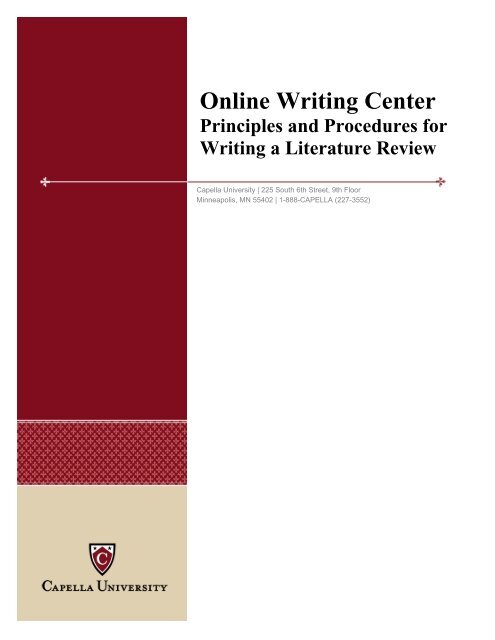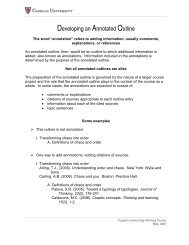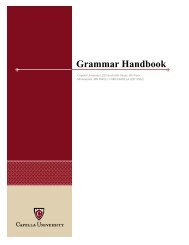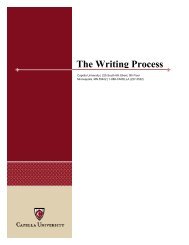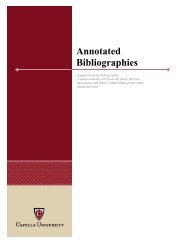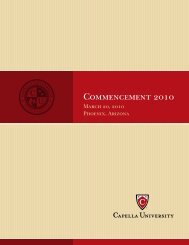Online Writing Center - Capella University
Online Writing Center - Capella University
Online Writing Center - Capella University
Create successful ePaper yourself
Turn your PDF publications into a flip-book with our unique Google optimized e-Paper software.
<strong>Online</strong> <strong>Writing</strong> <strong>Center</strong><br />
Principles and Procedures for<br />
<strong>Writing</strong> a Literature Review<br />
<strong>Capella</strong> <strong>University</strong> | 225 South 6th Street, 9th Floor<br />
Minneapolis, MN 55402 | 1-888-CAPELLA (227-3552)
Table of Contents<br />
5/31/2007 1:24 PM<br />
<strong>Capella</strong> Proprietary and Confidential<br />
Literature Review<br />
Principles and Procedures for <strong>Writing</strong> a Literature Review…………………………………..3<br />
Introduction: The Purpose of a Literature Review………………………………………………3<br />
Defining the Literature Review………………………………………………………..…………...5<br />
Placement of a Literature Review in the Academic Conversation…………………………….5<br />
Crafting the Literature Review……………………………………………………………………..7<br />
Goals of the Literature Review…………………………………………………………………….7<br />
Tools for Showing Synthesis in the Body Paragraph of the Literature Review………………7<br />
Definitions..………………………………………………………………………………………7<br />
Examples………………………………………………………………………………………...8<br />
Acknowledging the Critics……………………………………………………………………...9<br />
Applying the Tools to the Literature Review…………………………………………………...10<br />
The <strong>Writing</strong> Process for the Literature Review………………………………………………..11<br />
References……………………………………………………………………………………………12<br />
Page 2 of 12
5/31/2007 1:24 PM<br />
<strong>Capella</strong> Proprietary and Confidential<br />
Principles and Procedures for <strong>Writing</strong> a Literature Review<br />
Introduction – The Purpose of a Literature Review<br />
Literature Review<br />
Entering an academic conversation involves many steps. Two of the most fundamental of<br />
these steps involves reading material in the field and forming a perspective on what you read.<br />
Academics demonstrate their perspective on the reading of the field by composing a literature<br />
review. A literature review traces the genealogy of a topic in the field; it notes the history of<br />
the topic and the notable perspectives of others in the field who have addressed the topic. The<br />
purpose of a literature review is to “demonstrate that the writer has insightfully and critically<br />
surveyed relevant literature on his or her topic in order to convince an intended audience that<br />
this topic is worth addressing" (Clark, 2007, p.105). The literature review is not intended to<br />
report the literature, but instead to synthesize it.<br />
The literature review appears at many stages of your graduate education. Early in a graduate<br />
education, you will often be required to write a short literature review for a paper in a course to<br />
demonstrate analysis, synthesis, and evaluation i of the assigned readings for the course.<br />
Page 3 of 12
5/31/2007 1:24 PM<br />
<strong>Capella</strong> Proprietary and Confidential<br />
Literature Review<br />
The expectations for the literature review increase steadily throughout a doctoral program,<br />
finally culminating in a chapter-length literature review, which functions as the second chapter<br />
of the dissertation.<br />
How do you prepare to write informed reviews of the literature in your field?<br />
Page 4 of 12
5/31/2007 1:24 PM<br />
<strong>Capella</strong> Proprietary and Confidential<br />
Literature Review<br />
First, you must spend considerable time reading the academic literature of the field. Over time,<br />
you explore many topics through reading these academic sources, which include books, journal<br />
articles, and published studies and any other credible materials that work to add to the<br />
knowledge of your field. This ‘reading time’ constitutes the majority of your time in graduate<br />
school. The more you read, the more you begin to form an individual identity as a scholar<br />
through the choices you make as you read.<br />
At the beginning of your graduate career, you read the materials that your course assignments<br />
guide you to in the library. However, over time, you start to recognize the names of authors<br />
with whom you’ve agreed in the past. You also start to recognize the names of authors with<br />
whom you’ve disagreed in the past. You become familiar with journal names and publisher<br />
names, and you can start to research a topic based on more than the key words listed in the<br />
assignment. Through continued reading in your field, you gain the experience to make<br />
informed choices about which authors to align yourself within the formation of your own<br />
academic identity.<br />
Increased knowledge through reading comes through experience with multiple research<br />
projects, and that increasing knowledge also serves to shape your individual perspective on<br />
your own field of study. Over time, you focus your attention on a specific research area, and,<br />
ultimately, on a specialty area in which you will conduct research to complete a dissertation.<br />
Making these kinds of decisions about where you’ll conduct further research and writing marks<br />
your entry into the field as an individual scholar drawn to some topics and not persuaded by<br />
others.<br />
Defining the Literature Review<br />
Placement of a Literature Review in Academic Conversation<br />
A graduate education anticipates learners making choices and forming an individual identity as<br />
a scholar. Assignments requiring literature reviews are some of the touchstones in a graduate<br />
education that allow you to identify your individual voice and stance on important topics<br />
within a field. A graduate education culminates in the writing of a dissertation, your official<br />
entry into the academic conversation through the completion of a book-length project that<br />
advances the knowledge of the field. In a shorter, paper-length form, your literature review<br />
typically consists of several paragraphs placed early in the text to explain the history of the<br />
problem or issue and to explore what the field has said on the topic. The literature review<br />
establishes a context, a history, and a reason for why you are writing. You will also be asked<br />
to write paper-length literature reviews in which the review is a much more developed<br />
examination of the literature on a particular topic in the field. These literature reviews, short<br />
and long, culminate in a chapter-length literature review that serves to underpin your<br />
dissertation research.<br />
At <strong>Capella</strong>, the disciplines of Business, Education, Human Services, and Psychology structure<br />
the dissertation in the following way:<br />
Page 5 of 12
1. Introduction and problem statement<br />
2. Literature review<br />
3. Research and methodology<br />
4. Data analysis and results<br />
5. Conclusions and recommendations<br />
5/31/2007 1:24 PM<br />
<strong>Capella</strong> Proprietary and Confidential<br />
Literature Review<br />
Notice the placement of the literature review. In the context of a dissertation, the literature<br />
review comes immediately after the introduction. In the introduction, you give a picture of<br />
what the dissertation will do and what the dissertation will address, much as the first paragraph<br />
of an academic paper offers an introduction and a thesis statement that will guide the body of<br />
the paper. As with all literature reviews, Chapter 2, the literature review, establishes a context,<br />
a history, and a reason for the project.<br />
This early placement of the literature review is important for several reasons.<br />
• The literature review offers a critical look at existing research that’s significant to the<br />
writer’s topic.<br />
• The literature review demonstrates the writer’s knowledge of the field.<br />
• The literature review justifies the writer’s proposed study.<br />
• The literature review sets the context for the research.<br />
• The literature review defines which issues and authors are important to the writer and<br />
which are not.<br />
Thus, the literature review defines you as a writer and a scholar in the field. Readers can learn<br />
what you value and what you don’t by reading your review. In the literature review, you<br />
choose to include some sources while choosing not to include others. These choices offer a lot<br />
of information about who you are as a scholar for an audience familiar with the research in<br />
your field. For example, imagine that you are writing about educational theories. John Dewey<br />
serves as your foundational source for your literature review. You read two scholars who<br />
come after Dewey: Paolo Freire and Malcolm Knowles. You speak favorably about what<br />
Knowles adds to Dewey’s ideas, but you note several shortcomings in Freire’s assumptions.<br />
From those statements, readers in your field understand that you are aligned with the Knowles<br />
school of thought and not with the Freirian school of thought. Readers can also place what you<br />
value within the context of their own perspectives and within the larger issues of the field.<br />
In academic writing, the primary audience, readers in the field, works to situate new voices<br />
within the already-existing conversation. This audience will evaluate which sources you use in<br />
the context of their own perspectives—their own established identity in the academic<br />
conversation. Just as you have your individual perspective on the topic for which you are<br />
composing a literature review, so will your audience. That’s why the literature review is so<br />
important. In short, your literature review defines where you stand in the academic<br />
conversation of your field within the context of those who came before you and for those who<br />
will come after you.<br />
Page 6 of 12
Goals of the Literature Review<br />
5/31/2007 1:24 PM<br />
<strong>Capella</strong> Proprietary and Confidential<br />
Crafting the Literature Review<br />
Literature Review<br />
For a literature review to be accepted as a credible representation of your understanding of<br />
your field, it must accomplish several goals.<br />
• The literature review must be organized around and related directly to research<br />
questions that you are developing.<br />
• The literature review must synthesize results into a summary of what’s known and not<br />
known.<br />
• The literature review must identify areas of controversy in the literature.<br />
• The literature review must formulate questions that need further research.<br />
In the following instructional module, you’ll work with three tools to help you craft a literature<br />
review that accomplishes all of these goals. Whether you are writing a short literature review<br />
within a paper or Chapter 2 of your dissertation, these tools will assist you in synthesizing your<br />
readings to compose reviews that give your readers a clear understanding of the issues and<br />
scholars that you are reviewing and will outline your stance on the position.<br />
Tools for Showing Synthesis in the Body Paragraphs of the Literature Review – Definition,<br />
Examples, and Acknowledging the Critics<br />
Three basic tools will help you share your synthesis of the literature you read with your<br />
audience: definitions, examples, and acknowledging your critics.<br />
Definitions<br />
Definitions bolster your argument by making sure that you and the reader are starting on the<br />
same page and with the same definitions. Definitions can be a derived from multiple sources,<br />
from dictionaries to reference books to seminal works in a field.<br />
For example, if your topic is the color blue, you might rely on a reputable art dictionary to<br />
define what blue means in terms of the color spectrum. You might also rely on a book of<br />
literary criticism to enhance that definition by looking at how the color blue has historically<br />
been used to symbolize courage in great western literature, including Shakespeare. Combining<br />
these two definitions gives you a definition of your own for the color blue in the context of<br />
your specific topic--of your unique argument.<br />
When using key words and concepts in the field for your literature review, remember that over<br />
time, terms and concepts gather many meanings. Simply relying on a dictionary definition<br />
might not be enough to define a term for your audience, a group of academics in your field.<br />
For example, unconscious is a term that has many meanings in the field of psychology. That<br />
term means different things to, say, Sigmund Freud than it does to those who come after him,<br />
like, for example, Jacques LaCan. Therefore, in a literature review about psychoanalytic<br />
theories with an academic audience, it will be important to talk about which scholar you<br />
Page 7 of 12
5/31/2007 1:24 PM<br />
<strong>Capella</strong> Proprietary and Confidential<br />
Literature Review<br />
follow, which definition of that term you agree with, and how you will apply that definition to<br />
your own theory.<br />
You can also use definitions to define a concept or topic by what it is not.<br />
For example, if you follow LaCan’s definition of the unconscious, you might want to include<br />
Freud’s definition to show where it differs from LaCan’s. You will also want to offer specific<br />
reasons to justify why those differences prompted you to side with LaCan’s definition.<br />
Remember: definitions can be used to define both what something is and what it is not.<br />
Examples<br />
Examples bolster your argument by adding an extra level of explanation for the reader.<br />
Examples often serve to make a concept concrete for the reader. Imagine that you are trying to<br />
explain a method for teaching. After the key terms in the method are defined, take the next<br />
step: offering examples of the method at work.<br />
Notice the pattern of examples in the section you just read above on definitions:<br />
Definitions can be a derived from multiple sources, from dictionaries to reference<br />
books to seminal works in a field.<br />
For example, if your topic is the color blue, you might rely on a reputable art<br />
dictionary to define what blue means in terms of the color spectrum.<br />
Simply relying on a dictionary definition might not be enough to define a term for your<br />
audience, a group of academics in your field.<br />
For example, unconscious is a term that has many meanings in the field of psychology.<br />
That term means different things to, say, Sigmund Freud that it does to those who come<br />
after him, like, for example, Jacques LaCan.<br />
You can also use definitions to define a concept or topic by what it is not.<br />
For example, if you follow LaCan’s definition of the unconscious, you might want to<br />
include Freud’s definition to show where it differs from LaCan’s and why those<br />
differences don’t offer a definition that works within the context of your argument.<br />
In these examples, a statement is made, and that statement is then applied—‘teased out’—by<br />
the use of examples. Examples, either hypothetical or from the literature, bring your synthesis<br />
to life by offering real-life connections to your theories and interpretations. As a <strong>Capella</strong><br />
scholar-practitioner, connecting theory to practice underpins your educational journey, and<br />
examples are an excellent and primary method for making that theory-to-practice connection.<br />
Remember: examples can be used to enhance definitions and to give the reader another<br />
perspective on your evaluative statements made during the literature review.<br />
Page 8 of 12
Acknowledging the Critics<br />
5/31/2007 1:24 PM<br />
<strong>Capella</strong> Proprietary and Confidential<br />
Literature Review<br />
While many in your audience will agree with your position on the topic of your literature<br />
review, many will not. An important function of the literature review is to acknowledge what<br />
critics of your argument say. To create an informed perspective about the literature of a<br />
field, you must read many perspectives about key issues and discussions within your field. In<br />
an academic conversation, a writer who has looked at all sides of the argument comes across as<br />
an informed and balanced speaker. Just as working to define something by what it is not is an<br />
effective tool, so is presenting a position on a subject and including the perspectives and<br />
arguments that differ from that position.<br />
For example, let’s say that you make the statement that many in your field have conjectured<br />
that the sky is blue. You define blue in terms of meteorology, and you give examples of what<br />
you mean by the color blue. During your research, you discover many speakers who say that<br />
the sky is not blue. Some of these speakers are not credible, so you discard those dissenting<br />
positions. But some of those speakers are credible. They are published in peer-reviewed<br />
journals, and they have many followers at universities across the country. Leaving those<br />
credible sources out of your literature review creates a slanted perspective on the body of<br />
literature in the field, while acknowledging those critics shows that you have considered all<br />
perspectives, but for at least one reason, you have decided to reject those critics in favor of<br />
your chosen perspective.<br />
Acknowledging the critics also offers you the chance to create new ways of thinking about<br />
your topic within your field. For example, imagine that you address the way in which two<br />
different scholars, Scholar A and Scholar B, use a shape to discuss a concept in the field. You<br />
note that Scholar A and those after him have conjectured that the term ‘square’ is effective for<br />
describing a concept that encompasses four terms.<br />
You also acknowledge that Scholar B has conjectured that the term ‘square,’ which implies<br />
that all four sides are equal in length, is too limiting, and, thus, must be changed to the term<br />
‘quadrangle.’<br />
Page 9 of 12
5/31/2007 1:24 PM<br />
<strong>Capella</strong> Proprietary and Confidential<br />
Literature Review<br />
While you acknowledge the validity of Scholar B’s purpose in expanding the term, you also<br />
note that in the context of the concept being discussed, all angles in Scholar B’s conception are<br />
actually 90 degree angles. In fact, then, in spite the difference in terms, both scholars are really<br />
talking about a similar concept. In essence, from your perspective, Scholar B supports Scholar<br />
A’s assertion, but with a different definition of square, which, perhaps, you re-label as<br />
“rectangle.”<br />
In this example, noting the other side of the argument has led you to a new understanding of<br />
the concept addressed by both Scholars A and B. While acknowledging the critic shows depth<br />
of exposure to the literature of the field, in this case, that acknowledgement has also led to a<br />
new interpretation not yet noted by your field, filling a gap in the field while boosting your<br />
credibility as a new voice entering the field.<br />
The review of the literature you create with definitions, examples, and your acknowledgement<br />
of critics is your synthesis of the literature of your field. You will not just be summarizing the<br />
literature, but instead, finding connections through tools like the ones described here. When<br />
you finish organizing and drafting it, this synthesis becomes a persuasive argument which<br />
creates the context in which your readers will understand your research.<br />
Applying the Tools to the Literature Review<br />
Now that you’ve explored the tools, you are ready to apply them to a literature review in your<br />
field.<br />
Once you’ve selected your literature review, work to locate the definitions, examples, and<br />
acknowledgement of the critics used by the author. As you read your sample literature review,<br />
make notes in the margins, and locate where the writer has used the tools you’ve learned in this<br />
module. You may also want to highlight each example in a different color. For example, you<br />
may mark definitions in blue, examples in green, and acknowledging the critics in red.<br />
Once you’ve completed this process, ask yourself the following questions.<br />
Which definitions worked well? Why?<br />
Which definitions could have worked better? How?<br />
Which definitions convinced you because they came from credible sources? Why?<br />
Page 10 of 12
5/31/2007 1:24 PM<br />
<strong>Capella</strong> Proprietary and Confidential<br />
Literature Review<br />
Which definitions did not convince you due to lack of credibility of the source? Why?<br />
Which examples worked well? Why?<br />
Which examples could have worked better? How?<br />
Which examples convinced you because they came from credible sources? Why?<br />
Which examples did not convince you due to lack of credibility of the source? Why?<br />
Which acknowledgments of critics worked well? Why?<br />
Which acknowledgments of critics could have worked better? How?<br />
Which acknowledgement of critics convinced you because they came from credible sources?<br />
Why?<br />
Which acknowledgments of critics did not convince you due to lack of credibility of the<br />
source? Why?<br />
For all three tools, as you identify them and question their effectiveness, work to find methods<br />
that you might want to use in your own literature reviews.<br />
Do you see methods of incorporating these tools that you’d like to model in your own review?<br />
Note what you like and what you don’t like in these examples. You can often learn as much<br />
about your own writing process by charting what you don’t like as you can learn by charting<br />
what you like. Remember: the literature reviews posted above were deemed successful<br />
Chapter 2 literature reviews for <strong>Capella</strong> dissertations, so applying the tools to these reviews<br />
gives you practice with the dissertation standards for <strong>Capella</strong>.<br />
The <strong>Writing</strong> Process for the Literature Review<br />
Like any academic writing process, crafting an effective literature review is not a linear<br />
process. As the writing map below indicates, the literature review writing process is recursive<br />
and iterative.<br />
Edit<br />
Revise<br />
Proofread<br />
Propose<br />
Draft<br />
Take<br />
Get an<br />
idea<br />
Do focused<br />
research<br />
Read<br />
Refine idea<br />
Read more<br />
Page 11 of 12
5/31/2007 1:24 PM<br />
<strong>Capella</strong> Proprietary and Confidential<br />
Literature Review<br />
Reminders<br />
Upon your completion of each draft in this recursive process, remember to compare the<br />
following important outcomes of the literature review to ensure that your review satisfies the<br />
expectations of your audience.<br />
• Reviews background of the problem area<br />
• Identifies merits of previous studies (who, what, when, where, why, how)<br />
For the dissertation project:<br />
• Helps to select research methods<br />
• Provides required theoretical framework<br />
• Establishes context and rationale for the study<br />
• Establishes that study does not unintentionally duplicate work already published<br />
• Shows how your study contributes to the knowledge base of the field<br />
References<br />
Clark, I. L. (2007). <strong>Writing</strong> the successful thesis and dissertation: Entering the conversation.<br />
Upper Saddle River, NJ: Prentice Hall.<br />
Page 12 of 12


